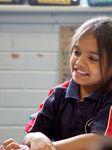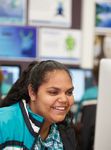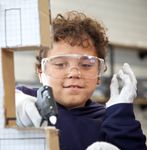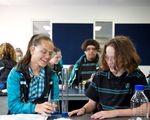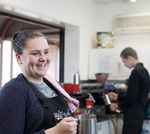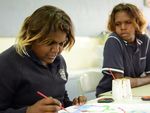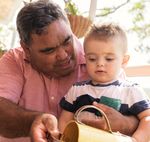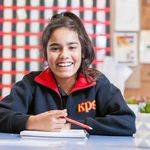Aboriginal Education Strategy - 2019 to 2029
←
→
Page content transcription
If your browser does not render page correctly, please read the page content below
Acknowledgements We would like to thank and acknowledge the following contributors to the Aboriginal education strategy (the strategy): • South Australian Aboriginal Education and Training Consultative Council for leading the consultation and co- designing the strategy with the Department for Education • the panel of Aboriginal education and child development experts who provided strategic advice on teaching and learning, professional development and curriculum matters: xx Professor Peter Buckskin xx Dr Kaye Price xx Professor Lester-Irabinna Rigney xx Dr Christopher Matthews xx Karen Glover xx Professor Daryle Rigney • April Lawrie, Commissioner for Aboriginal Children and Young People, who led the development of the strategy as the department’s former Aboriginal education director • all those within the Aboriginal community, elders, families, departmental staff, and Aboriginal children and young people who have contributed their time and voices to the development of this strategy. Note: Department for Education use the term ‘Aboriginal’ to refer to people who identify as Aboriginal, Torres Strait Islander, or both Aboriginal and Torres Strait Islander. This term is preferred by Aboriginal South Australians and the department.
Contents Foreword 4 This strategy 6 Vision 7 Principles 7 How this strategy is structured 8 Our approach 9 Current landscape 10 Goals 12 Achieving our goals 16 Key focus areas for reform 18 Implementation and accountability framework 20 Goals, measures and indicators 22
Minister’s foreword
I am proud to deliver this statewide, Aboriginal
education strategy for South Australian Aboriginal
children, young people, their families and
communities.
As we strive to build the best education system in
the nation, we need to support growth for every
child, in every class, in every school.
We know that some of our students will need
tailored and focused strategies to improve their
educational outcomes.
We want to see every Aboriginal child in South
Australia as a proud and confident learner, who
strives to achieve their highest potential.
This strategy is about sharpening our focus to
ensure all Aboriginal children and young people
are successful learners and highly skilled for
their future.
It defines how we will go about improving the
educational outcomes for Aboriginal children
and young people, whether in the early years,
throughout their schooling or as they embark on
pathways to further education and employment.
It is an ambitious strategy, with 10-year goals and
key objectives that will require the collaboration
and commitment of educators, leaders, learners,
families and communities.
I am confident that together, we can help all young
Aboriginal people to achieve their very best.
Hon John Gardner MP
Minister for Education
4 Aboriginal Education Strategy 2019 to 2029Foreword from Foreword from
Professor Peter Buckskin the Chief Executive
Chairperson, South Australian Aboriginal This strategy requires our department to take
Education Training and Consultative Council action to improve the way we work alongside
families and communities to accelerate learning
It was a privilege for the South Australian
outcomes for Aboriginal children and young people.
Aboriginal Education and Training Consultative
Council (SAAETCC) to work with the Department It commits us to holding high expectations for
for Education to co-design a long-term Aboriginal Aboriginal students, but also for ourselves. We
education strategy that will ensure our students must be brave, focused and committed to bringing
not only survive, but thrive academically, culturally the long-term aspirations of this strategy to life.
and socially throughout their learning journey.
Through building the cultural responsiveness
Our approach took into account Aboriginal of education services, we will ensure Aboriginal
nation building, the United Nations Declaration children and young people feel safe, valued and
on the Rights of Indigenous Peoples and the supported for the unique knowledge and strengths
principles of self-determination. The key element they bring to education.
of the co-design process was to consult with
The next steps will need meaningful collaboration
Aboriginal parents, caregivers, communities and
between skilled educators, learners and families,
organisations.
including applying a culturally appropriate
We listened and heard a call for a culturally curriculum that encourages student engagement
safe and responsive education system, with and comprehensive individual learning plans for
transparent implementation plans, key every Aboriginal student.
deliverables and rigorous reporting arrangements.
We want to ensure the effectiveness of the strategy
We will support Aboriginal parents and community for Aboriginal children and young people across its
to have stronger relationships with teachers, 10-year lifespan. This will require ongoing review of
school leaders and education services. The our progress and the ability to adjust our approach
combination of getting the ‘child ready for school’ as necessary. Reviews will be informed by evidence
and ‘the school ready for the child’ requires the in conjunction with Aboriginal education experts.
relationship between the child and teacher to be
I look forward to seeing our statewide team come
the centre of the learning partnership.
together in support of this strategy.
SAAETCC seeks your support as we strive to
realise the strategy’s vision for our future.
Rick Persse
Chief Executive, Department for Education
Professor Peter Buckskin PSM FACE
Chair SAAETCC
Aboriginal Education Strategy 2019 to 2029 5This strategy
This 10-year strategy is guided by the Department for Education’s vision
and principles, viewed as essential for Aboriginal children and young
people to achieve growth and success. The document will be a core policy
and practice driver for the department, outlining the goals and objectives
we are committed to delivering. This will require working alongside
Aboriginal families and communities and building a confident, culturally
inclusive workforce ready to identify and implement the actions necessary
to maximise the strategy’s success. It will be supported by a strong
action plan and an implementation framework developed in the spirit of
reconciliation and ensure Aboriginal young people are on pathways to
success.
6 Aboriginal Education Strategy 2019 to 2029Vision
Each Aboriginal child and young person is a proud and confident
learner, achieving at their highest potential.
Principles
These principles will guide the implementation of this strategy within preschools, children’s
centres, schools and education services across South Australia. The department will be
courageous, innovative and focused in implementing new initiatives informed by and
co-designed alongside the Aboriginal community.
1. Highest expectations – We will have the highest 4. Community engagement – We will hear,
expectations for Aboriginal children and young seek and respect the voices of Aboriginal
people’s achievement. people and their representative organisations,
and encourage participation of Aboriginal
2. Accessibility and responsiveness – We will
students, parents, carers, families and
partner with families and communities to
communities across our services.
create culturally safe and inclusive learning
environments, identify opportunities for growth 5. Accountability – We will be transparent and
and respond to barriers for Aboriginal children accountable for improving learning outcomes,
and young people. using allocated resources to achieve growth
and development for all Aboriginal children and
3. Culture and identity – We will acknowledge,
young people.
value and respect Aboriginal knowledge,
wisdom and expertise, including our existing
Aboriginal staff and students and we will
adopt local approaches to teaching Aboriginal
histories, cultures and languages.
Aboriginal Education Strategy 2019 to 2029 7How this strategy
is structured
The strategy highlights the importance of
empowering parents, carers, family and community, and
being a culturally responsive organisation to support
education and development of Aboriginal children and
young people.
8 Aboriginal Education Strategy 2019 to 2029Strong identity, high achievement, The child life journey: our goals
positive futures: our approach The strategy follows the child or young person’s life
journey. Our goals expand across the early years
The Aboriginal Education Strategy 2019 to 2029
into schooling and are followed by pathways to
promotes a ‘child-centred’ approach to learning
success beyond school.
within an Aboriginal community context, which
considers how a child or young person’s development Regular attendance at preschool and school is
is affected by their social relationships and the world essential to building a good life. By achieving
around them.1 our goals and strengthening our enablers,
workforce and cultural inclusiveness, we
A culturally responsive service delivery model and
will lift school attendance for Aboriginal
teaching to the strengths of the child’s cultural
children and young people.
knowledge, experience, frames of reference and
performance styles, will make learning outcomes 1. Aboriginal children develop foundations
more relevant and effective for Aboriginal children for success in the early years.
and young people.2
2. Aboriginal children and
The diagram signifies the child or young person, young people excel at school.
surrounded by the essential elements for a successful
3. Aboriginal young people are
educational journey. They are strengthened by their
on pathways to success.
culture, identity, language, country and belonging.
Their learning and development is supported by
the strength of family, elders, community and the
The child’s Early
influence of leaders, educators and peers including years
journey
a strong Aboriginal and non-Aboriginal workforce.
These people are equipped to encourage the
culturally appropriate experiences that will contribute
to the learning success of the early years, schooling
and future pathways. Excel at
school
GOALS
OOLS PA
SCH TH
RS W
A
IDENTITY
AY
E
Pathways
YY
to success
E
S
UR
EARL
LA
ELDERS
CULT
NGU E
AG
TEAC
COU
IT Y
TR
G
IN
N
Y
BELONG
HE
UN
Aboriginal and
RS
non-Aboriginal
M
PE M
ER CO Workforce
S FA MILY
1
ENABLED BY
Bronfenbrenner U, The Ecology of Human Development: Experiments by nature and design, Cambridge MA: Harvard University Press, 1979
also see www.ecrh.edu.au/docs/default-source/resources/ipsp/child-centred-curriculum-planning.pdf?sfvrsn=4 ‘Child-centred’ refers to
ways of teaching and treating children that sees the child’s needs and wishes as the most important aspect
2
Gay G, Teaching To And Through Cultural Diversity, Curriculum Inquiry, Vol 43, 2013- Issue 1, 2013
Aboriginal Education Strategy 2019 to 2029 9Current landscape
As the First Australians, Aboriginal Over half of all Aboriginal South
people have the oldest continuing Australians live in metropolitan
cultures in human history. We Adelaide with the remainder dispersed
acknowledge that Aboriginal people across the state in regional, rural
and their nations have endured past and remote communities. Aboriginal
injustices and dispossession as a result South Australians are a young and
of colonisation. While these impacts growing group, with about a third of
continue to be intergenerational, there the population aged between 0 and 14
is strengthened resilience amongst years. Approximately 13, 000 children
Aboriginal communities.3 South Australia and young people identify as Aboriginal
is home to more than 50 Aboriginal across our early years services and
language groups, each with distinct schools.
beliefs and cultural practices. Aboriginal
people have the right to access an
education that respects
and promotes their own culture
and language.4
10 Aboriginal Education Strategy 2019 to 2029Vulnerability School years
Aboriginal children and young people have The school years are a critical time to develop
made some significant gains in learning and quality educator, child and young person
development over recent years, but there is more relationships and to engage with families and
work to be done to ensure every Aboriginal South communities to support learning participation.
Australian can enjoy the lifelong benefits of a The Australian Curriculum recognises
world-class education. Education is a compelling Aboriginal histories, cultures and languages as a
social determinant of identity, health and future life cross-curriculum priority within various learning
expectancy for all Aboriginal people.5 areas. This benefits both Aboriginal and non-
Aboriginal students.7
Developmental vulnerability in any area is a strong
predictor of future school and wellbeing outcomes. School retention rates to year 12 are improving.
The Australian Early Development Census data The number of Aboriginal young people completing
shows that around half of all Aboriginal children the South Australian Certificate of Education
enrolled in the first year of school were vulnerable (SACE) increased from 238 in 2013 to 377 in
in one or more areas measured. Data collected 2017, across all schools. As of 2017, the year 8
by the department shows that 20% of Aboriginal to 12 student retention rate for Aboriginal young
children have a verifiable disability. people was 65% compared with 50% in 2013,
demonstrating more Aboriginal young people are
remaining at school until year 12.
Early years
The first 1,000 days of life present a unique
opportunity to develop the foundations for
Workforce
optimal health, growth and cognitive development. Aboriginal employees represent 2.5% of the
Preschool attendance can have an impact on department’s workforce, however the proportion
how ready children are for the transition from of Aboriginal staff who are employed as teachers
early years to primary school. By the age of 4, and leaders is lower. This is another area for the
nearly 100% of Aboriginal children are enrolled department to focus our efforts through developing
in preschool,6 however attendance is not high. a plan for Aboriginal employment.
Increasing access to quality early childhood
learning and development services for all
Aboriginal children is a priority.
3
Bringing Them Home Report: National Inquiry into the Separation of Aboriginal and Torres Strait Islander Children from Their Families,
Sir Ronald Wilson, 1997 www.humanrights.gov.au/sites/default/files/content/pdf/social_justice/bringing_them_home_report.pdf
4
United Nations Declaration on the Rights of Indigenous Peoples, Article 14 and the Coolangatta Statement, 6 August 1999
5
Department for Health, The Social Determinants of Health, June 2013
6
Department for Education Term 3 Preschool Data Collection, Australian Bureau of Statistics, 2014, ‘Estimates and Projections, Aboriginal
and Torres Strait Islander Australians,’ 2001 to 2026, cat. no. 3238.0
6
www.australiancurriculum.edu.au/f-10-curriculum/cross-curriculum-priorities/aboriginal-and-torres-strait-islander-histories-and-cultures/
www.australiancurriculum.edu.au/f-10-curriculum/languages/framework-for-aboriginal-languages-and-torres-strait-islander-languages/
Aboriginal Education Strategy 2019 to 2029 11Goals
We will work together with parents and communities to provide
Aboriginal children with quality learning and development experiences,
enabling a strong foundation for school transitions.
12 Aboriginal Education Strategy 2019 to 2029Aboriginal children
develop foundations
for success in the
early years
We are committed to providing access to
Objectives
high-quality early childhood education and
care experiences for Aboriginal children 1. Health and developmental services are
and their families. These should be culturally provided to Aboriginal children and families
appropriate and build on the strengths in accessible and culturally welcoming ways
of Aboriginal nations and their cultures. and locations.
These experiences will be complemented by 2. Aboriginal children access and participate
engaging families and communities in their in quality early childhood learning and care
child’s learning and development planning. that incorporates meaningful engagement
A child’s earliest environmental, learning and from families and communities.
developmental experiences are critical to the 3. Aboriginal children and their families have
way their brain develops. Nurturing, attachment in place the foundations for learning as they
and growth are important for all children to transition from home to early childhood
develop for success in education, work and life. services to school and between schools.
Positive gains made in the early years will have 4. Aboriginal families and communities are
lasting developmental and educational benefits. active participants in the governance of child
Research has shown that Aboriginal children and family centres.
who attend preschool for at least one or more
years are better able to successfully transition
to school and achieve better results than those 10-year goal
who do not.
Aboriginal children’s cognitive, emotional, social
and communication skills and overall health and
wellbeing, support them to succeed.
Aboriginal Education Strategy 2019 to 2029 13Aboriginal children Objectives
and young people 1. Aboriginal children achieve growth in their
learning, including Standard Australian
excel at school English and numeracy skills at or above
their year-appropriate level.
Aboriginal children and young people are 2. Aboriginal children’s experience of learning
culturally secure learners with the essential is relevant to their own lives, as it is reflective
skills in literacy, numeracy, creativity and of the identity, language and culture of
innovation to take on the future. Aboriginal people.
We will have the highest expectations for 3. Pedagogy is culturally responsive and
Aboriginal children and young people and through developed through a student-centred approach
teaching to each student’s unique strengths we will to teaching based on high expectations and
promote achievement and increase wellbeing. We quality relationships.
will acknowledge the importance of maintaining
4. Comprehensive, individual, quality learning
and developing first languages as a mechanism for
plans are developed to support student
learning Standard Australian English.
achievement and transitions through
Literacy and numeracy skills are the foundation engagement and discussion with schools,
for every child and young person’s ability to families and Aboriginal children and
engage with learning. Together with social and young people.
communication skills they provide the basis for
5. Aboriginal children and young people are
successful engagement both within the school and
capable of demonstrating Aboriginal cultural
outside in the local community.
pride and knowledge.
Strong identity, belonging, culture and history are
a source of strength and resilience for Aboriginal
people and their communities. A meaningful and 10-year goal
culturally appropriate education helps keep culture
Aboriginal children meet or exceed the same
strong, builds Aboriginal nations and enhances
standards of achievement for literacy and numeracy
learning and participation for Aboriginal students.
as non-Aboriginal students.
14 Aboriginal Education Strategy 2019 to 2029Objectives
1. Aboriginal young people engage with,
participate and achieve in science, technology,
Aboriginal young engineering and mathematics (STEM) as
potential pathways to industries of the future.
people are on 2. Aboriginal young people are actively supported
pathways to success to make successful transitions to educational
or employment pathways, through relationships
between education providers, industry and
Aboriginal young people transition to Aboriginal communities.
further study, training and employment
with the knowledge, skills and dispositions 3. Aboriginal young people successfully complete
to be successful, active participants in their their SACE and/or vocational education
community. qualifications.
We will support all Aboriginal young people to 4. Aboriginal young people develop their cultural
achieve at their highest potential, so they can identity, life skills, confidence and resilience
pursue further studies, training and employment necessary to successfully transition from school
and become active community members able to into future pathways.
maintain their intellectual, physical and spiritual
wellbeing, individually and collectively.
10-year goal
A young person’s path to lifelong health,
wellbeing and economic prosperity is All Aboriginal students achieve their SACE or
strengthened through pride in cultural identity vocational education qualification at the same
and academic success, particularly in the senior rate as non-Aboriginal students.
years of schooling.
Achieving a senior secondary certificate has
significance for many students ‘to the way they
imagine themselves as students, as family
members, and as members of the community’.8
Completion of the South Australian Certificate
of Education (SACE) or obtaining a vocational
qualification increases future educational and
employment options for Aboriginal young people.
8
The SACE Board of South Australia’s
Aboriginal Education Strategy 2017 to 2020
Aboriginal Education Strategy 2019 to 2029 15Achieving our goals
Our goals and objectives for Aboriginal We recognise that Aboriginal children
children and young people are and young people have better learning
supported by 2 fundamental areas, experiences when our staff are
informed by Aboriginal voices. Every culturally responsive to their needs. We
Aboriginal community in South Australia acknowledge the role of the Aboriginal
is unique and we will encourage the workforce across our schools and
‘nation rebuilding’9 process wherever services in making a positive difference
possible, understanding that Aboriginal to Aboriginal education outcomes.
people hold responsibility for the culture
and identity development of their
children and young people.
16 Aboriginal Education Strategy 2019 to 2029Engaging Aboriginal communities Building a strong, culturally
to develop the culture and identity responsive organisation
of their children and young people We will become a culturally responsive organisation
where our services are relevant to the cultural and
Our schools will work collaboratively with
learning needs of Aboriginal children and young
Aboriginal communities toward successful
people. Our schools will be strengthened by creating
educational outcomes for Aboriginal students.
teaching and learning environments that respect the
We will create safe and welcoming environments
culture, languages, knowledge and experience of
for Aboriginal families and communities to enable
Aboriginal people.10
them to connect with schools.
The relationship a child or young person has with
We know the significant role that families and
their teacher is an influential force in their ability
communities play in the confidence and success
to achieve in the classroom. Through professional
of Aboriginal children and young people. We will
development, opportunities for collaboration and
create opportunities for students to have active
engagement with Aboriginal people, we will ensure
involvement in Aboriginal community and cultural
our teachers are well equipped to build relationships
life, and enhance culturally responsive learning
and teach in culturally responsive ways.
that reflects the aspirations of Aboriginal families
and communities. We will acknowledge the cultural knowledges,
community connections, linguistic diversity and
We will focus on improving family and community
wisdom of our Aboriginal workforce. We will value
satisfaction through nation building and
them as an asset to building a culturally responsive
reconciliation processes and supporting schools to
organisation and to enabling the meaningful
teach Aboriginal content.
engagement of Aboriginal children and young
people, their families and communities.
We will:
• create opportunities for communities to engage We will:
in the teaching and delivery of Aboriginal
• be culturally responsive and ethical through our
cultural knowledge and languages within
governance, policies, practice and services
education settings
• develop and grow a strong, sustainable
• engage and encourage families to be active
Aboriginal workforce
participants in their child’s health, development
and learning through contributing to individual • develop the confidence and capability of
learning plans our workforce to build high-expectation
relationships with Aboriginal students, families
• provide an opportunity for all children and
and communities and to teach in culturally
young people to interact and engage with
responsive ways
Aboriginal elders and community members
in a respectful way • develop our capability to design and implement
strategies responsive to the cultural
• implement governance structures that
background and histories of Aboriginal children
include and empower local Aboriginal families
and young people, the local community and or
and communities in decision-making and
nation group.
service delivery.
9
https://government.unimelb.edu.au/research/governance-and-regulation/past-research-projects/governance-and-performance/indigenous-
nation-building-theory-practice-and-its-emergence-in-australias-public-policy-discourse
10
Including strengthening the implementation of focus areas 1.4 and 2.4 of the Australian Professional Standards for Teachers and the
leadership professional practice 5: ‘engaging and working with the community’ of the Australian Professional Standard for Principals
11
Stronger, Smarter Institute, High Expectation Relationships – A Foundation for Quality Learning Environments in all Australian Schools, 2014
Aboriginal Education Strategy 2019 to 2029 17Key focus
areas for reform
Lifting outcomes for Aboriginal children and young
people will be achieved by delivering on reforms
and improvements in key focus areas.
18 Aboriginal Education Strategy 2019 to 2029Teaching practice and Workforce development
curriculum delivery Develop our people to work together to strengthen
the learning and life outcomes for Aboriginal
Transform the delivery of curriculum and
children and young people. Enable all staff to
learning through strengthening Aboriginal input,
become culturally responsive through professional
valuing and respecting Aboriginal knowledge,
development, community connections and
language, culture and histories. Our pedagogy
ensuring that we deliver culturally appropriate
will encompass the foundation of knowledge
services to children, families and communities.
that Aboriginal children and young people bring
Grow our Aboriginal workforce and support our
with them and use their cultural repertoire in the
existing Aboriginal staff.
learning environment. Aboriginal students will
experience high-quality teaching and learning,
that challenges them intellectually, supports
and resonates with their cultural identity and
Funding policy
empowers them to achieve success prior to Review funding and accountability measures to
school, within school, in further study and in the ensure Aboriginal targeted resourcing reaches
workforce. Aboriginal learners who need extra support to
achieve their highest potential. Where appropriate,
funding and accountability will be adapted to align
Languages with the policy objectives of this strategy.
Strengthen and reinvigorate the learning of
Aboriginal languages in children’s centres,
preschools and schools, including language
Aboriginal governance, service
revival and maintaining strong active languages. design and delivery
Recognise the linguistic rights of Aboriginal
Include Aboriginal perspectives and decision
children and students, building on home languages
making in the governance, design and delivery of
through family and community engagement. Move
our services to optimise Aboriginal outcomes at
toward a bilingual education model that ensures
the local level. Through understanding, valuing and
proficiency for Anangu children in Pitjantjatjara or
embedding Aboriginal service standards within
Yankunytjatjara and Standard Australian English as
our local partnership structures we can build the
an additional language.
capacity of our services to meet the educational
needs of Aboriginal children and young people.
Engagement and governance
Recognise families and communities as keepers of
knowledge that will support and grow the culture
and identity of learners. Value and strengthen the
role of our existing Aboriginal workforce in engaging
Aboriginal families and communities to be active
participants in their child’s learning journey.
Aboriginal Education Strategy 2019 to 2029 19Implementation
and accountability
framework
The strategy’s implementation and accountability framework
will ensure we are transparent and responsive to progressing
learning and developmental outcomes
for Aboriginal children and young people.
20 Aboriginal Education Strategy 2019 to 2029Commitment to implementation Transparency to community
We will engage with teachers, leaders and support We will provide opportunities to share outcomes
services to drive action locally. Implementation with communities. We will publish the strategy,
plans will set out key actions and milestones implementation plans and public progress reports
that can be monitored and supported through on the department’s website. We will work in
our accountability mechanisms, using feedback, partnership with the South Australian Aboriginal
evaluation and evidence to adjust our approach Education and Training Consultative Council
and continually improve. (SAAETCC) to engage with Aboriginal communities
as well as with representative organisations to
review and develop future implementation plans in
Accountability to continuous improvement cycles.
external stakeholders
We will seek expert Aboriginal advice about Research and development
improving learning outcomes for Aboriginal
We will explore new areas of best practice in
children and young people. Our accountability will
early childhood and education, addressing
be strengthened by engaging Aboriginal people
new challenges that arise throughout the
who are external to the department and who have
implementation phase. Through research and
expertise in education, child development, culture,
development we will maintain our commitment
community and nation building.
to providing the best outcomes for Aboriginal
children and young people.
Strengthening our
internal accountability
We will strengthen our internal accountability
for funding and performance outcomes through
our school improvement model, which will
provide a mechanism to support the growth and
development of Aboriginal children and young
people. The department’s Senior Executive
Group will oversee and monitor progress against
the strategy at a systemic, partnership
and school level.
Aboriginal Education Strategy 2019 to 2029 21Goals, measures
and indicators
As a department, we aim to achieve growth and progress
for all children and young people. We will set and track
milestones for Aboriginal children and young people
that align with those that exist for all children and young
people. High-level measures and indicators will support
the monitoring of progress throughout the lifetime of
the strategy. Additional measures will be developed to
support actions and implementation as we continually
review outcomes.
22 Aboriginal Education Strategy 2019 to 2029Overarching measures / indicators
What we will measure Indicators of success*
Wellbeing and engagement indicators Selected results from the Student Wellbeing and Engagement Survey
Attendance / absence Rates of school attendance and absence
Aboriginal children develop foundations for success in the early years
What we will measure Indicators of success*
Preschool attendance Percentage of Aboriginal children attending preschool
On school entry assessment 2019 onwards Under development
Percentage of Aboriginal children developmentally vulnerable in 1 or
Australian Early Development Census more domains
– every 3 years Percentage of Aboriginal children developmentally vulnerable in 2 or
more domains
Indicators of preschool reading levels year 1 and 2 Percentage of Aboriginal children reading at an age-appropriate level
Percentage of Aboriginal children able to phonically decode at age-
Phonics screening check –2018 year 1
appropriate standard
Percentage of Aboriginal babies and children receiving appropriate
Universal home visiting (parent and child
health and developmental health checks 0 to 8 weeks, 6 to 9 months, 12
assessment)
months, 18 months to 2 years and preschool
NAPLAN years 3, 5 and 7 reading, writing and Percentage of Aboriginal children progressing and achieving at or above
numeracy results their year-appropriate level
Aboriginal children and young people excel at school
What we will measure Indicators of success*
NAPLAN years 3, 5 and 7 reading, writing and Percentage of Aboriginal children progressing and
numeracy results achieving at or above their year-appropriate level
NAPLAN assessment participation Percentage of Aboriginal children participating in NAPLAN testing
Percentage of Aboriginal children demonstrating the expected
PAT M and PAT R tests in schools
achievement in PAT M and PAT R tests
Aboriginal young people are on pathways to success
What we will measure Indicators of success*
Percentage of Aboriginal children progressing and
NAPLAN year 9 results
achieving at or above their year-appropriate level
NAPLAN assessment participation Percentage of Aboriginal children participating in NAPLAN testing
Retention years 10 to 11 and Percentage of Aboriginal children still at school between years 10 and 11
11 to 12 and from years 11 to 12
Percentage of Aboriginal young people undertaking and completing
SACE completion
SACE
Percentage of Aboriginal young people with mathematics and/or science
SACE subject selection
subjects as part of their SACE
Percentage of Aboriginal young people undertaking and completing VET
VET completion
(AQF Cert I and II, AQF Cert II and above)
Aboriginal Education Strategy 2019 to 2029 23The Journey of Success
This artwork represents that the journey of success The patchwork background represents the many
for a young Aboriginal person is shaped by a solid different communities that students come from,
foundation in learning and development. with the blue representing coastal and the earth
brown representing inland.
Commencing at the bottom left corner, the first
meeting place represents the baby being born and The artwork gradient gradually gets lighter and
the antenatal and early childhood care provided to the culminates with the bright yellow star and sun
mother and family. symbol in the top right of the artwork, depicting the
successful outcome of going to preschool and school.
The journey then continues along the pathway to the
next meeting place, which represents preschool entry. The original artwork, Journey of Success, was
created by Jordan Lovegrove from the Ngarrindjeri
Subsequent meeting places depict learning, meeting
Aboriginal Nation specifically for the Department for
teachers and friends along the way, represented
Education in South Australia. The artwork symbolises
by the dots, and reaching a culmination point
the intent of the Aboriginal Education Strategy and
represented by the next meeting place before
reconciliation for the department.
continuing on the journey.
The meeting places outside of the pathway
represent families and their support of learning
and development.
Published November 2018 EDU867You can also read

